Smoke like Elliot’s creepy yellow cat drapes itself in gray fur paws down every street, mixing with the pollution of more traffic (car, motorcycle, rickshaw, truck, bus, foot) than any one city can bare. It’s off-season steaming hot. There’s no running water to drink or bathe in. Odors of incense hang around your neck and the only refuge is in a tiny shop booth, but then you are attacked by overzealous vendors of everything imaginable. I’ve now armed myself – copy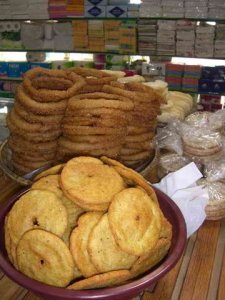 ing Chinese girls we met on the Annapurna trek – with a neck scarf which I can pull up over my nose when the air is just unbearable, which is most of the time. We all look like bank robbers.
ing Chinese girls we met on the Annapurna trek – with a neck scarf which I can pull up over my nose when the air is just unbearable, which is most of the time. We all look like bank robbers.
Since we’ve had a couple of restoration days in Kathmandu, and with a friend Karen, and Jim’s assistant Brad joining us for the Everest trek, I took advantage of Karen’s expertise (she lived in Nepal 18 months) to shop for glass beaded necklaces and glass bracelets in bright colors. The bangles are fragile, but they cost about seven cents a piece. The glass beaded necklaces are made in the moment at a vendor’s stall in the Muslim side of town called Terai. Sitting before rows of bright greens, reds, yellows, golds, pinks, and every kind of mixture, it was hard to ‘pick out wha t you want’ as Jim said, and they’ll make it for you. A necklace of about ten strands cost a pittance. In a special area, men tied long strings to their big toe and threaded the beads by hand to make the pattern one requested. It’s crowded, primitive, but an old craft form that’s faded from our shores.
t you want’ as Jim said, and they’ll make it for you. A necklace of about ten strands cost a pittance. In a special area, men tied long strings to their big toe and threaded the beads by hand to make the pattern one requested. It’s crowded, primitive, but an old craft form that’s faded from our shores.
In the many stalls in this area are T-shirts embroidered on the spot with Free Tibet or whatever you want; felted pocket books of every hue; elaborately embroidered scarves and jackets, and cheap red velvet scuffs beaded with sequins. Pashmina shawls and cashmere sweaters really from Kashmir are more numerous than rice krispies in a box. No color forgotten, there is cashmere for the masses. Curious is the story of the shahatush wool from a rare Tibetan antelope living at 14,000 feet on a r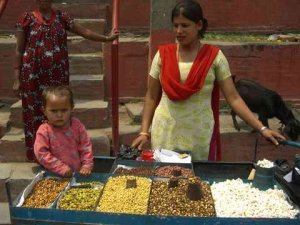 are treeless steppe in Tibet. This finest of all cashmere wools (a scarf can be pulled through a small wedding band), once coveted by the jet set of Europe and America, can no longer be sold because the antelopes were being wiped out as their wool was traded for illegal tiger bone and skin, rhino horns, bear gall bladders, Musk pods, all used for Oriental medicine. A new effort to copy the original shawls which cost up to 10,000 dollars has been made so that the antelope are no longer slaughtered, but farmed and sheared like other wool b
are treeless steppe in Tibet. This finest of all cashmere wools (a scarf can be pulled through a small wedding band), once coveted by the jet set of Europe and America, can no longer be sold because the antelopes were being wiped out as their wool was traded for illegal tiger bone and skin, rhino horns, bear gall bladders, Musk pods, all used for Oriental medicine. A new effort to copy the original shawls which cost up to 10,000 dollars has been made so that the antelope are no longer slaughtered, but farmed and sheared like other wool b earing sheep and antelopes, at least that’s what one salesman told me. Kathmandu once trafficked in the illegal wool, but no longer. A pure shawl is impossible to find. Some times a low-grade farmed shahatush wool might be woven into a cashmere scarf but it’s rare to find those as well.
earing sheep and antelopes, at least that’s what one salesman told me. Kathmandu once trafficked in the illegal wool, but no longer. A pure shawl is impossible to find. Some times a low-grade farmed shahatush wool might be woven into a cashmere scarf but it’s rare to find those as well.
Fabrics, silk, cotton, wool, nylon, are purchased in whatever color scheme one wishes, and then made to your own measurement in a day or two. Nepali women spend their days shopping in these tiny spaces choosing new saris. Tailors of men’s clothing likewise fashion suits out of fine fabrics, not too far from the baskets of garlic, ginger, herbs and teas, fresh tofu and leis of orange and yellow marigolds. It’s hard to see everything available because you are about to be run down by a motorcycle or a bicycle drawn rickshaw or a car or you arrive in a circular area which is another Hindu temple with lions and strange goddesses smudged with red faces. Below your feet are pot holes and burned dead animals and garbage, so you try to keep out of the mire. It’s impossible. Brad was standing outside one little bin waiting for us to buy glass bangles an d got bombed by a pidgeon. Such is life.
d got bombed by a pidgeon. Such is life.
In the morning Karen had taken me to the European-American supermarket where every kind of familiar food was available. Shelves after shelves offered familiar brands of toilet paper, Saran wrap, cookies, crackers, even grits and macaroni and cheese in a box, soap powders, masses of toothbrushes and toothpaste (although you cannot brush your teeth with sink water if you are a tourist) and home made cakes and desserts mixed in with olive oils, mayonnaise, soy and A-1 sauce. We were stocking up on thi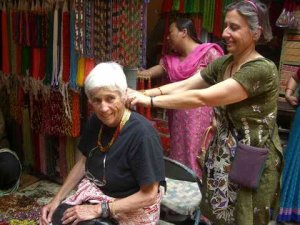 ngs we might want to eat on the trek. I was intrigued by John Brown products in green cans, tuna, wild salmon, caviar, herrings, etc. And there were plenty of pickles and even capers. Basically, we have to carry everything we think we are going to need for the next two weeks. Another case of the “what if” stock.
ngs we might want to eat on the trek. I was intrigued by John Brown products in green cans, tuna, wild salmon, caviar, herrings, etc. And there were plenty of pickles and even capers. Basically, we have to carry everything we think we are going to need for the next two weeks. Another case of the “what if” stock.
Yesterday, because we must have a tourist visa to enter India, Jim and I arrived early at the Indian Embassy and were told by the guard we needed a number. We were given 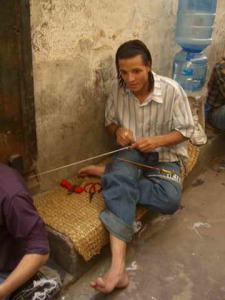 81. That means at 7 a.m. there were already 81 or more people ahead of us. But we didn’t think much of it, and returned at 9:30 when the gates opened. We waited in line outside in the sun about an hour. Then when we finally got in and followed the dash to an open area on the side of the building, we found a impossible packed line of faux hippies, Buddhist monks, and young girls in daring attire waiting in line as well. The first project is to fill out what is called a fax form. This is sent to the state department of each person’s home country. Then you wait in line to turn that in. We waited and waited and waited. I finally found a chair and crocheted to pass the time. There was no etiquette of line forming. People just broke in where they willed. But we tried to be patient as the clock ticked to 12 noon. A signed said that the faxes would not be accepted after 12 noon. Well, when that hour arrived, there were still 30 people in front of us, and the one single clerk who was doing the work, sh
81. That means at 7 a.m. there were already 81 or more people ahead of us. But we didn’t think much of it, and returned at 9:30 when the gates opened. We waited in line outside in the sun about an hour. Then when we finally got in and followed the dash to an open area on the side of the building, we found a impossible packed line of faux hippies, Buddhist monks, and young girls in daring attire waiting in line as well. The first project is to fill out what is called a fax form. This is sent to the state department of each person’s home country. Then you wait in line to turn that in. We waited and waited and waited. I finally found a chair and crocheted to pass the time. There was no etiquette of line forming. People just broke in where they willed. But we tried to be patient as the clock ticked to 12 noon. A signed said that the faxes would not be accepted after 12 noon. Well, when that hour arrived, there were still 30 people in front of us, and the one single clerk who was doing the work, sh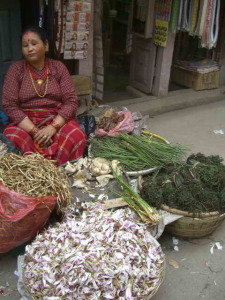 ut the window and said he would not accept any more fax applications that day. Why in the world, we mulled, did they give us a number and let us in in the first place if we weren’t going to receive attention? Embassies are not easy anywhere, but the Indian Embassy was a disaster. And we had no recourse but to leave and talk to the police guards (Nepali) who said we had to come about 2 in the morning to line up for the number.
ut the window and said he would not accept any more fax applications that day. Why in the world, we mulled, did they give us a number and let us in in the first place if we weren’t going to receive attention? Embassies are not easy anywhere, but the Indian Embassy was a disaster. And we had no recourse but to leave and talk to the police guards (Nepali) who said we had to come about 2 in the morning to line up for the number.
Jim was stirred to find an alternative way – I was sure there must be one myself. And he found a travel agency that, if we paid a fee, would do the work for us and we’d have the visa by the time we return from the Everest expedition in two weeks. Here’s hoping. We have had to rewrite the two weeks when we were supposed to go to Tibet a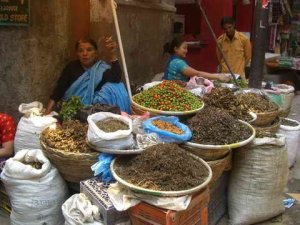 nd to Mt. Kailash because China will not open the borders of Tibet to anyone until after the Olympics in August. Since India was a curiosity for me and isn’t that far, we’ve chosen a different program to go there and see Old Tibet in Laddock (combined with a trek through those high and dry mountains) and a visit to Darmsala, the residency of the Dalai Lama, were we hope to participate in one of his audiences. If he is in town, as now scheduled, we will be there. Also I’ll have a chance to see the Taj Mahal. Might as well.
nd to Mt. Kailash because China will not open the borders of Tibet to anyone until after the Olympics in August. Since India was a curiosity for me and isn’t that far, we’ve chosen a different program to go there and see Old Tibet in Laddock (combined with a trek through those high and dry mountains) and a visit to Darmsala, the residency of the Dalai Lama, were we hope to participate in one of his audiences. If he is in town, as now scheduled, we will be there. Also I’ll have a chance to see the Taj Mahal. Might as well.
Shopping in Kathmandu
Photos: Supermarket breads; Pidgeon Drop square; snack cart – notice popcorn; symphony in reds; bead row; Karen and I sample beads; bead stringer; Merchant of fiddlehead ferns; merchant of teas and peas.

Dear Friend,
I am writing on behalf of http://www.coolgiftsnepal.com which is a personalized online gift service to Nepal. We have launched our new and secure website and are proud of our commitment to bring the ease of online shopping to enable our patrons to select from a wide range of well-chosen gift items.
Coolgiftsnepal.com was founded on a desire to bring the best products without compromising on quality at the most competitive prices.
I invite you to browse our website at http://www.coolgiftsnepal.com and would be grateful if you would consider adding this link on your website for the benefit of your members in the Nepali community. Please also feel free to pass this information on to your associates in your organization.
Please do not hesitate to contact me if I can provide any further information.
Many thanks and best regards.
Anita
Email: coolgiftsnepal@gmail.com